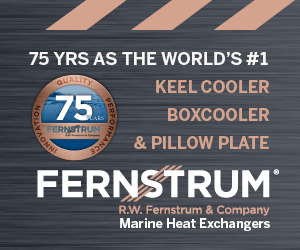Litrico Gives Update On Container Vessel Progress
The first speaker at the St. Louis Inland River Seminar, supported by Fox Smith LLC and held at the Missouri Athletic Club downtown September 20, was Sal Litrico, CEO of American Patriot Container Transport LLC. Litrico gave an update on his company’s much-discussed plans for a new type of waterborne container service aboard patented, purpose-built, self-powered container vessels. “It’s taken eight years and a whole lot of money to get to this point,” but the next stage is in view, he said.
After graduating from the State University of New York Maritime College, Litrico sailed in various licensed deck officer positions, including master, with American Export Lines and Interstate & Ocean Transport until 1983, when he moved to Tampa to join the shore staff of Maritrans as port captain. After holding numerous professional, management and executive positions there, Litrico became vice president of Maritrans in 1990.
In 2004, he became president and CEO of TECO Transport, later selling the fleet to United Maritime Group. He then became president and CEO for the United Maritime Group, with management responsibility for three distinct operating fleets. Since 2014, Litrico has led American Patriot Container Transport LLC (APTC), a subsidiary of American Patriot Holdings, developing a unique concept in waterborne container carriage.
In December 2021, Litrico announced an RFP to build (APTC’s) first four vessels, saying he expected to make an announcement in April of this year. That announcement was delayed. At the seminar, Litrico said he hopes to announce which shipyard will be constructing the first four vessels within the next few months. Where that shipyard is located makes a difference, he said, since his vessels are a new type, with crew and manning requirements to be worked out with the local Coast Guard officer in charge of marine inspections. Capt. Dave Dewey, who attended the seminar, confirmed that he has been consulting with Litrico on crew requirements. Litrico said APCT plans to collaborate with the Seamen’s Church Institute in developing simulations for the new vessels, which will help work out those requirements. “We will have our own training program for mates and captains,” he said.
The biggest revelation of Litrico’s talk was that his company had decided to switch the fuels on the proposed new vessels from LNG to methanol.
Litrico thinks the signs are favorable for his model. “In the next 10 years, containerized cargoes will double,” he said. Two independent third-party studies have examined his model, looking especially at outbound and inbound cargo balance: one by Informa Economics, and one by CK Americas. He pointed to increased container movements after the Panama Canal expansion in 2014, and ongoing difficulties with rail service. He said that even pre-COVID, container dwell times on the West Coast ports averaged 10 to 12 days and were already an issue with shippers. Now, dwell times of 60 days are not uncommon. His patented new vessels will be able to carry heavier containers than are allowed on most roads, including refrigerated containers. That opens the way for refrigerated poultry and meat containers from South America, he said.
The vessels, with a patented bow design, three Z-drives and five bow thrusters each, and a 7-10-foot draft, will be able to travel at 13 mph. versus the average speed of a tow of 4 or 5 mph. The new vessels will be either “liners,” which can carry up to 2,400 TEUs and are too large to pass through locks; or smaller hybrid vessels, designed to lock through and serve ports like Joliet, Ill.; Kansas City and Jefferson City, Mo.; and Fort Smith, Ark. Ports like St. Louis and Memphis could handle both types of vessels. “The model has to be speed, and the lowest landed cost per container,” he said. If an agreement with a shipyard is signed soon, he said, the first vessels could be operational by the end of 2024.
Litrico has been signing agreements with ports and terminals along the rivers to ensure they have the facilities to handle containerized cargoes. Besides the ports already mentioned, strategic partners include the ports of Chicago, Ill.; Herculaneum, Mo.; and New Orleans, La. “We have to line up all the pieces contractually and logistically,” he said.
Litrico added that “Cargoes have to be balanced” between outbound and inbound cargoes. Ultimately, “economies of scale” will make the project feasible and open up what amounts to a new north-south trade lane, he said.
Jim Hurley, CEO of Hawtex Development Corporation, APCT’s partner in the venture, said, “Our ports do not compete against each other.” Hawtex is developing a terminal in collaboration with Fred Weber/Riverview Commerce Park LLC in Herculaneum, Mo., integrating a 300-plus-acre adjacent parcel owned by The Doe Run Company.
Litrico named mid-2025 as the target date for when he hopes the new service will be operational. He presents the service as not competing directly with any existing models of water transport, but instead as opening up a brand-new model and competing with railroads. “We will not go after pocket cargoes,” he said, unlike past experiments in container-on-barge. “We are busy signing up customers. Some of the big-box stores have told us they could bury us in cargoes if we started developing today.” He said the new service, once operational, would “stay away from hazardous cargoes until we have competed for a while.”
Note: More coverage from the St. Louis Inland River Seminar will appear in next week’s issue.



